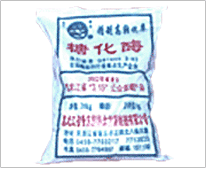Products
I. Physical appearance and main technical specifications
Spec |
Solid dosage form |
Liquid dosage form |
|||
Physical appearance |
Brown powder |
Brown liquid |
|||
Enzyme activity unit (ug/ or u/ml) |
50000 |
80000 |
100000 |
50000 |
100000 |
Working temperature |
Optimal temperature: 60¡æ |
||||
Working pH value |
Optimal pH value: 3.0-5.0 |
||||
Density (g/ml) |
1.25 |
||||
Product performance standard |
QB 1805.2 |
||||
Enzyme activity unit definition: the amount of enzyme required to produce 1mg of glucosein with 1g solid enzyme powder or 1ml in 1 hour under 40¡æ, pH 4.6.
II. Packing, storage and transportation
Solid dosage form: Plastic bag, net weight 20kg/bag.
Liquid dosage form: plastic bucket, net weight 30kg/bucket.
Transport and store in cool and dry place and prevent from rain, moisture and sunlight.
Solid, if stored at 25¡æ, will retain its full activity for a period up to 6 months. Liquid, if stored at 25¡æ, will retain its full activity for a period up to 3 months.
III. Applications and features
This product can be used in alcohol, starch sugar, mnosodium glutamate, antibiotic, citric acid, beer industry and distilled spirit, millet wine and many other fermentation industries. This product has stable quality and is easy to use. Use continuous saccharification to improve product quality and reduce cost.
IV. Using methods and precautions
1. Alcohol industry: After heating, cool ingredients to 62¡æ and adjust the pH to 4.2-4.5. Add in gluco-amylase at a suggested rate of 80-200 u/g ingredient. Hold for 30-60 minutes at the temperature of 60¡æ-62¡æ.
2. Starch sugar, monosodium glutamate, antibiotic, citric acid industry: After liquefying, cool ingredients to 60¡æ-62¡æ and adjust the pH to 4.2-4.5. Add in gluco-amylase to a suggested rate of 100-300u/g ingredient. Maintain the temperature and saccharify.
3. Beer industry: When manufacturing "dry beer", add in gluco-amylase before saccharification fermentation at a suggested rate of 40-100u/g malt.
4. Chinese white, yellow, Koo rice wine industry: The use of gluco-amylase can increase alcohol concentration.
5. The dosage of enzyme varies with materials and processes. It needs to increase the dosage to reduce saccharification period.
6. Starch contents must come into full contact with the enzyme for highly effective fermentation. The bigger the contact area and the longer the contact time given, the better will be the outcome. Intermittent saccharification requires thorough mixing and successive saccharification requires constant flow-rate.
7. The temperature must be strictly controlled at about 60¡æ. While maintaining temperature, heat must be evenly distributed. Avoid sudden or uneven high heat exposure.
V. Working principle and influencing factors
1. Working principle
This enzyme is derived through extraction and refinement from the aspergillus niger van tiegh and its mutation strains. It is also know as glucoamylase. It can change starch to glucose.
2. Effects of pH on activity and stability
Effective pH is 3.0-5.5, and optimal pH is 4.0-4.5.
3. Effects of temperature on activity and stability
Effective temperature is 40¡æ-65¡æ, and optimal temperature is 58¡æ-60¡æ.
4. Suppressant
The majority of heavy metal, i.e. copper, silver, mercury, lead, etc. act as inhibitors against gluco-amylase.



